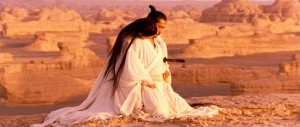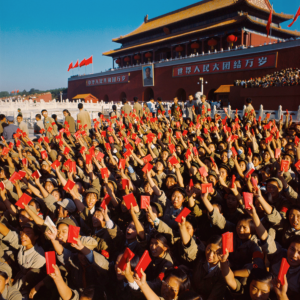
Photo taken from the movie Hero by Zhang Yimou.
In the movie Hero the same portion of a story is told four times, each time with a different color (red, blue, green, and white) and a slightly different plot to the story. Each time the story is told the main characters, Flying Snow and Brocken Sword have a different relationship and their actions in the story are different.
For the final scene, they wear white and they are purely together as they die and things become calm and simple, as seen through the color white.
Denotations: In the scene Brocken Sword had just died or is in the process of dying white the sword in his chest. Flying Snow calmly talks to a dying Brocken Sword saying that they will be going home, and Flying Snow kills herself with the sword that is killing Brocken Sword. The film also cuts to where Nameless is confronting the king and in that chaotic part of the scene there is all black. Lastly the backdrop for the white scene is the natural dessert landscape instead of the colored backdrops for the other colors such as in the red scene all of the leaves building being red.
Connotations: Although Flying Snow was the one to kill Brocken Sword when she charged at him, he took the hit, completely giving into the blow and not trying to block himself with his own sword. He calmly let into death. Looking more closely at the last part of the scene where Flying Snow is whispering to Brocken Sword telling him how they are going home together. There is a calm in the part of the movie even though she had killed her lover she is calm as she believes that they will travel together home. Also to bring in the natural landscape (as this white scene is the only one to have the natural setting), when Flying Snow says they are going home, that home is that they are returning to is the nature as represented in the natural background. The white robs that they are wearing represents the purity. Yes Flying Snow kills Brocken Sword but as they die they are finally together, deigning together with the one that they love and at peace with that. This is seen in the way that Brocken Sword does not fight Flying Snow and instead lets him kill her. He is giving into the one he loves because he would rather die than fight her back. Together they are dying by the same sword yet they could not look more peaceful and pure as they sit together with the wind moving their spotless white robes. It inflicts the pure calming feeling even after the deaths of two lovers.
focus is set and well maintained





